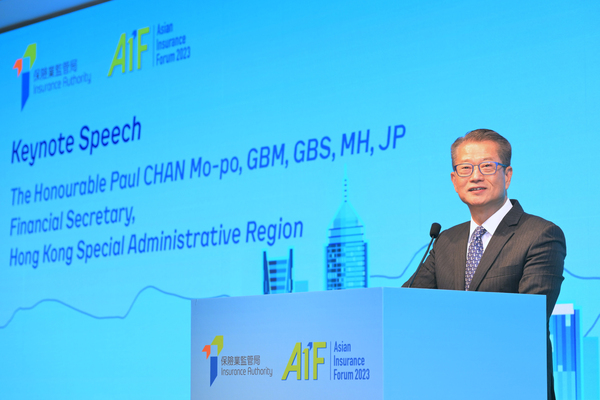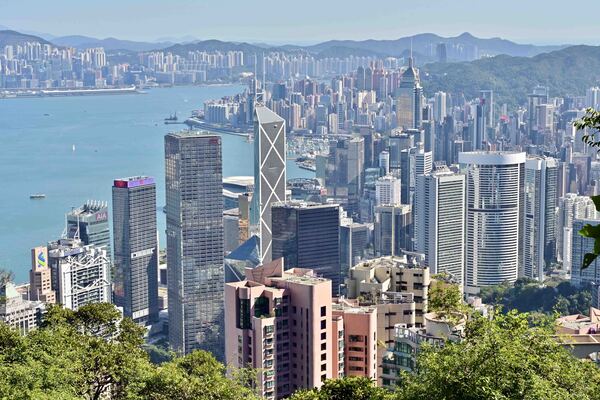INNOVATION IS OUR STRENGTH: FS
8-12-2023
Alphabetical Index
依字母搜索

The theme of the forum is "Striving for Enhanced Global Financial Stability & Resilience". The Chief Executive and many distinguished speakers have shared their insightful perspectives on a wide range of issues. Now, please allow me to take some time to update you on how Hong Kong is doing on our financial stability and resilience, and share some observations about the development of Hong Kong's insurance industry.
As it nears the end of a momentous year, the world has found itself in a challenging global environment filled with complexities and tensions: slower global economic growth; higher-for-longer interest rates; supply chains being disrupted and reshaped by geopolitical fragmentation.
Commitment to financial stability
Despite these challenges, we remain highly confident about the financial stability of Hong Kong. Over the years, we have withstood trials and tribulations time and again. We have worked unceasingly to build a robust regulatory framework and strong buffers, maintaining a high degree of resilience to shocks.
To this end, we have established a high-level "cross-market, co-ordinated, and round-the-clock" monitoring system, covering all sectors of the financial market, so that we could detect looming risks. And I am glad to tell you that despite the volatility in the financial markets, there has been no untoward volatility.
Building resilience through development
But beyond maintaining the stability and security of the financial system, it is through consistently developing and enhancing our financial markets that we can strengthen our resilience.
And we know that in the highly competitive world of finance, we must not stop improving ourselves so that we will be able to stay ahead of our competition.
Our work on this front is multifaceted. You may well be aware of the establishment of a task force to boost the liquidity of the stock market by a combination of measures. They include bringing enhancements to our listing regime, market structure, trading mechanism, mutual market access arrangements with the Mainland, and attracting both international and Mainland capital and issuers to Hong Kong.
In particular, our Connect Schemes with the Mainland have been expanding and deepening. Now they have extended from products to more derivatives, covering stocks, bonds, ETFs (exchange-traded funds) and risk management products, like interest rate swaps and A50 index futures. Just a couple of weeks ago, we announced that China treasury bond future contracts will be launched in Hong Kong.
As renminbi is getting more popular as a trade, settlement and reserve currency, we are working very hard to further enhance our offshore RMB business hub status, by offering more products and risk management tools to enrich our ecosystem and, at the same time, upgrade the related infrastructure.
We are also making great strides to open up new markets to attract new capital and new issuers. ASEAN (Association of Southeast Asian Nations) and the Middle East are burgeoning, and they have both set out plans to modernise their infrastructure, pursue green transition and develop the digital economy. They are also seeking to diversify their sources of investment and the markets for their products.
With the concerted efforts of the Hong Kong team and the cordial response from these counterparts, we are seeing heartening results. Last week, the first ever Saudi Arabia ETF (exchange-trade fund) was listed on our stock exchange. This week – indeed yesterday and today – we are hosting the first ever PRIORITY Summit in Asia organised by the Saudi Arabia-based FII (Future Investment Initiative) Institute. Prominent figures from Saudi Arabia and around the world, in their speeches and interviews with media, have all recognised the unique attractiveness of Hong Kong as an international financial and business centre in this part of the world, converging capital, investors and talent from both the East and the West.
Developments in our insurance industry
Now allow me to share some observations about the development of the insurance industry in Hong Kong.
We are among the world's most open insurance centres. Seven of the top 10 insurers globally conduct their business here. The average gross premium was over $550 billion on average over the past few years. In 2022, the industry accounted for 3.6% of GDP (Gross Domestic Product) in Hong Kong.
And after some setbacks in 2022, the insurance industry is seeing a strong rebound this year. In the first three quarters of 2023, new office premiums of long-term business recorded an increase by more than 30% compared to the same period last year. The increase in demand for whole-life and critical illness protection was particularly impressive.
These figures demonstrate that the insurance industry has been coping well with myriad challenges and changes. And they also show the promising prospects of Hong Kong's insurance industry on the Mainland, in particular the Greater Bay Area (GBA). We will continue to work with the Mainland authorities to assist the insurance industry to open up more business opportunities in the GBA.
And here, allow me to highlight a few developments which may characterise the local industry's development in the future: innovation and technology, climate change, and the social value of insurance.
Innovation and technology for insurance
On technology and innovation, we have witnessed disruption brought by insurtech, as traditional insurers seek deeper co-operation with fintech start-ups and technology providers to develop new product and tools, or even new business models to service various aspects of the insurance value chain. Since we introduced the virtual insurance regime in 2017, we have thus far licensed four virtual insurers, and their businesses have been expanding. In 2022, the businesses of the virtual insurers in Hong Kong expanded by 2.5 times compared to the previous year. And increasing digitalisation has driven about 80% of insurers in Hong Kong to utilise digital channels to enhance business operations.
And virtual insurers are exploring new frontiers, for example offering products in areas that may have been left out previously by traditional insurers, like coverage for pets, including dogs, cats and turtles. And what's more, with digital native edge, some virtual insurers are taking further steps to innovate niche products such as cyber insurance for virtual assets. Certainly, with the greater popularity of Web3, there will likely be ample space for cybersecurity insurance as new types of risks are emerging. Trends have shown that such business is increasingly shifting from the traditional coverage of hardware damage and business disruption to cover more third-party risks on data leakage, litigation costs and public liabilities.
Tackling climate change
On climate change, the World Economic Forum has warned that climate and environmental risks are the core focus of global risk perceptions over the next few decades, but they are also the risks for which we are least prepared.
On a global scale, natural catastrophe events caused US$270 billion of economic losses last year, but only 44% of such risk was insured. In Asia, we face a much larger natural catastrophe protection gap of over 80% compared to the rest of the world. Intensified natural disasters have increased insurance and reinsurance costs, creating significant rise in the demand for alternative risk transfer to supplement the traditional reinsurance market.
That is why we are keen on developing the insurance-linked securities, or ILS market, which can play an effective role in offloading underwritten risks to the capital market. While the global ILS market has been growing steadily over the past decade, the proportion of natural catastrophe risks covered by ILS remains small, and this market in Asia, including the Mainland, is very much underdeveloped.
I think you know this well: with the concerted efforts of the Government, the Insurance Authority, industry stakeholders and our Mainland and overseas partners, we have so far issued four catastrophe bonds totalling US$560 million. That includes our recent issuance of catastrophe bonds for Chile in collaboration with the World Bank. It was also the first ILS product listed on the Hong Kong Stock Exchange.
Unleashing the social value of insurance
Finally, the social value of insurance. Let us not forget that insurance is an "economic shock absorber" and a "stabiliser for social harmony", which are important and fundamental roles that it should play in the community.
We are fully conscious of this undertaking. For instance, in 2019, the Government and the insurance industry worked together to launch two tax-deductible insurance products, the Voluntary Health Insurance Scheme and the Qualifying Deferred Annuity Policies, to encourage uptake of health insurance policy and early retirement planning. Both products have met with overwhelming response, with over 1 million and 260,000 policies issued respectively.
The momentum was reinforced by the Protection Linked Plan (PLP) launched in 2022. With simple product structure, reasonable mortality protection, and transparent fee structure, the PLP seeks to encourage the younger generation to start their retirement planning early, so as to narrow the protection gap and facilitate financial inclusion.
Financial Secretary Paul Chan gave these remarks at the Asian Insurance Forum 2023 on December 8.
PREVIOUSNEXT
Latest Business News
最新商業資訊
Property sales dip 10.4% 4-2-2025

The Land Registry logged 4,938 sale and purchase agreements for all building units received for registration in January, ...
Retail sales down 9.7% in December 3-2-2025

The value of total retail sales for December, provisionally estimated at $32.8 billion, was 9.7% less than in the same mo...
Economy grows 2.5% in 2024 3-2-2025

Hong Kong’s economy in the fourth quarter of 2024 increased 2.4% year-on-year, and grew 2.5% for 2024 as a whole.
Bay area opportunities abound 27-1-2025

There are a multitude of insole products on the market, but those designed specifically for foot shapes that cater to lo...